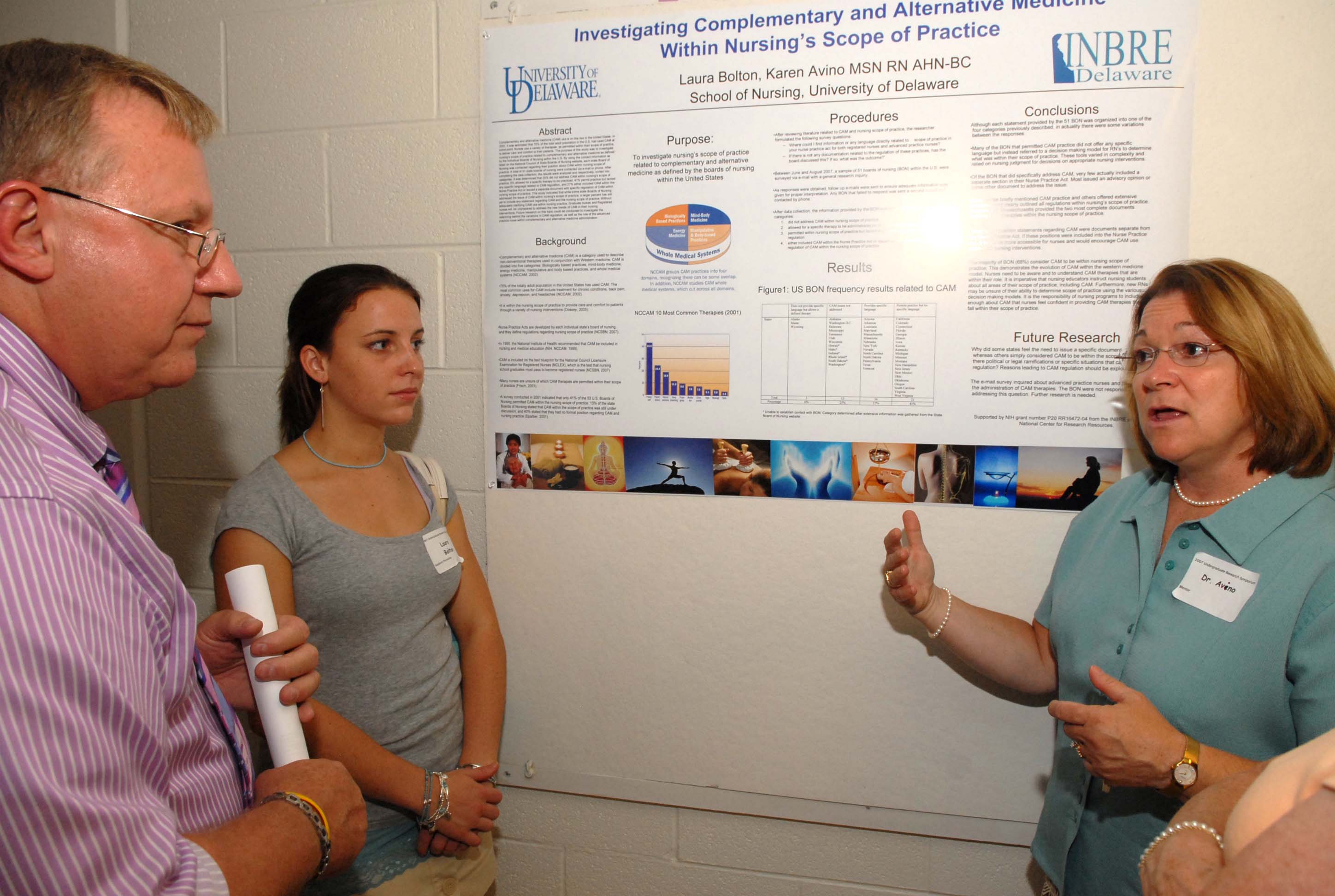
Investigating Complementary and Alternative Medicine Within Nursing’s Scope of Practice.
Laura Bolton and Karen Aveno
Department of Nursing
Ordered
alphabetically by student's last name
| Bolton |
Kelly | Lapenta |
O'Neal |
Sausen | Servas |
| Healy | Kostielney | McCartney | Penneys |
Schoenfeld |
Wagner |
| Ireton | Koterwas | Ogden | Russo |
 Promoting The Family’s Role in Medication Reconciliation: A Telephone Intervention Jennifer Healy and Kathy Riley-Lawless Pediatric
nurses are challenged to promote patient safety through medication
reconciliation, a process designed to decrease medication errors. While it has long been known that children
face an increased risk of medication errors, little is known about the
family’s
role in medication reconciliation as it pertains to decreasing
medication
errors. This study builds upon the
results of a previous study that focused on the barriers families
identified as
interfering with the medication reconciliation process (did not know
they had
to bring the medication, forgot the medication, or knew the
information). The
purposes of this study are to assess 1) the results of a telephone
intervention
method of contact (communication with a family member vs leaving a
message),
instructing families to bring their child’s medication to a
pre-surgical
appointment and 2) the ability of families to provide complete and
correct
medication information when they do not bring the medication.
Preliminary
results indicate that families are more likely to bring their child's
medications to the appointment when a caller speaks directly to a
family member
than if the reminder is left on the answering machine.
Also, many families are unable to provide
complete and accurate medication information when they do not bring the
medication. In conclusion, the medication reconciliation process is
improved
through a reminder call when the caller speaks directly to a family
member. Results will be used to guide
hospital policy. Research supported by
NIH grant number P20 RR16472-04 from the INBRE program of the
|
|
Obesity is a
national health problem that has been
significantly increasing over the past decades. The National Bureau of
Health
Statistics shows an increasing proportion of the population to be
obese. Data
from 1998-1994 shows 23% of adults 20 years or older were obese,
compared to
31% for 1999-2002. For the morbidly obese patients, surgery is the only
treatment that has been proven to have a long-term effect. The most
common type
of surgery is the Roux-en-Y-Gastric Bypass. Another more recent option
since
2001 is the Laparoscopic Adjustable Banding procedure. The main goal
for any
bariatric surgical procedure is to decrease weight therefore decreasing
or
eliminating comorbidities. The purpose of this study is to compare the
two
types of surgeries using a secondary analysis of a convenient sample of
1,070
patients from the Christiana Institute of Advance Surgery database.
Patient
demographics, difference in weight loss, and readmission rates between
the two
surgeries were analyzed. Results showed that there are no significant
pre-operative differences between the two bariatric surgeries except
for the
variables of sleep apnea and age. Younger patients and patients with
sleep
apnea had undergone more gastric bypass surgery compared to the
lap-band
surgery. There was no significant difference between the weight loss
over time
or the readmission rates. This study demonstrated that statistically
there is
no indicator for why a certain surgical technique is used over the
other. More
research is needed in this area to effectively compare the two
surgeries in
their long term outcomes and patient adaptations. Supported
by NIH Grant 2P20RR016472-07 under the INBRE Program of
the
|
|
Dorsiflexior and plantarflexor stimulation to aid in post-stroke hemiparetic gait Jessica H. Kelly, Katherine S. Rudolph, Trisha Kesar, Darcy Reisman, Stuart Binder-Macleod, Ramu Perumal1 Department of
Physical Therapy, 1Department of Mechanical Engineering
The
purpose of this study was to study how stimulation of the dorsiflexor
(DF) and
plantarflexor (PF) while walking on a treadmill can improve gait
performance of
individuals with post-stroke hemiparesis. We hypothesized that
stimulation of
the DF of the paretic leg would help to lift the foot during the swing
phase of
walking resulting in increased DF and reduced circumduction during
swing, as
well as increased DF at initial contact producing a better heel contact. We hypothesized that stimulation of the PF
would help increase push-off during late stance, and increase knee
flexion
during the swing phase of gait. Stimulation
was delivered with a variable-frequency train (VFT) functional electric
stimulation ( |
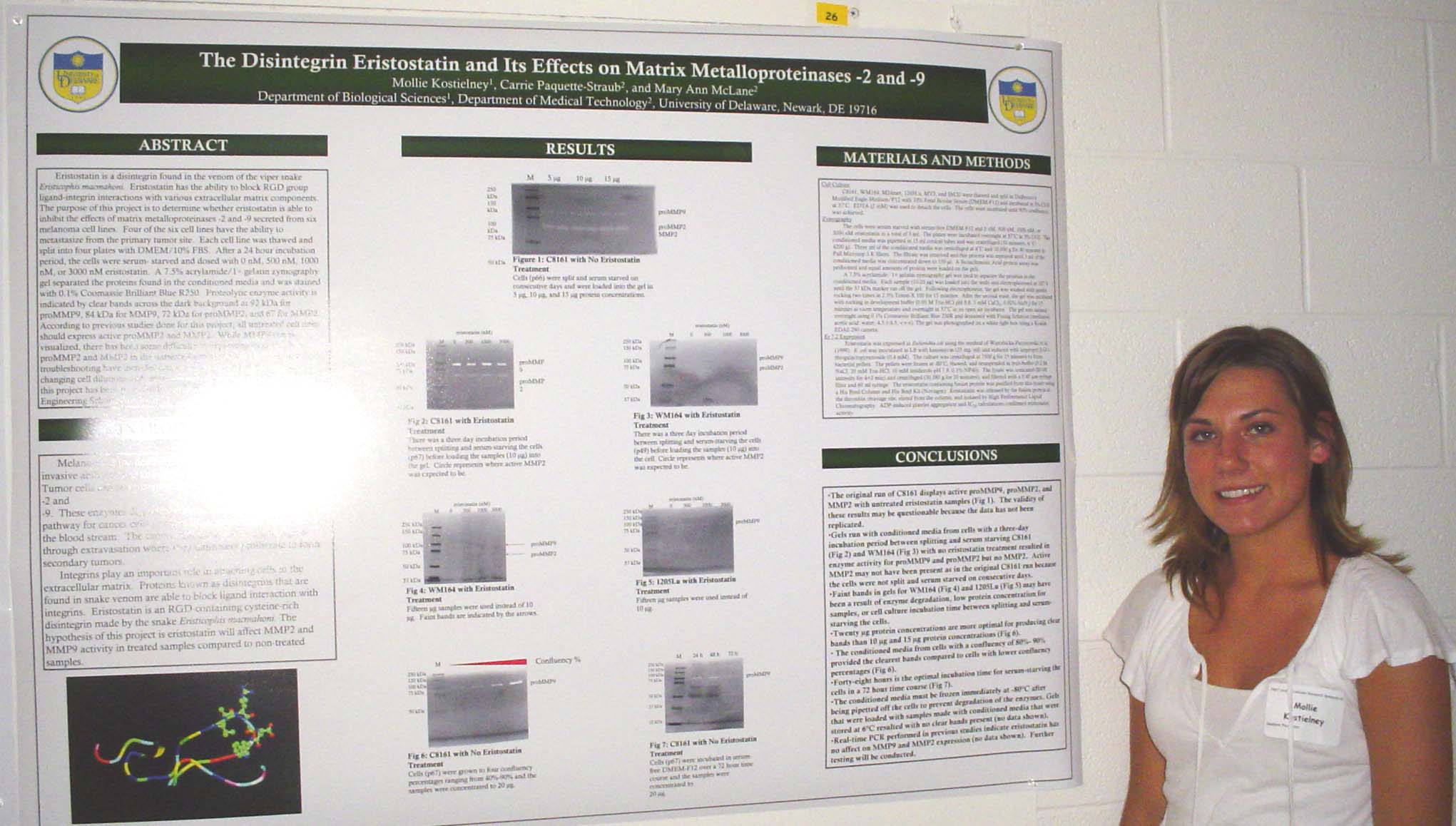 The Disintegrin Eristostatin and Its Effects on Matrix Metalloproteinases -2 and -9 Mollie Kostielney, Carrie Paquette-Straub, and Mary Ann McLane Department of Medical
Technology
Eristostatin
is a disintegrin found in the venom of the viper snake Eristicophis
macmahoni. Eristostatin
has the ability to block RGD group ligand-integrin interactions with
various
extracellular matrix components. The
purpose of this project is to determine whether Eristostatin is able to
inhibit
the effects of matrix metalloproteinases -2 and -9 secreted from six
melanoma
cell lines. Four of the six cell lines
have the ability to metastasize from the primary tumor site. Each
cell line was thawed and split into four
plates with DMEM/10% FBS. After a 24
hour incubation period, the cells were serum- starved and dosed with 0
nM, 500
nM, 1000 nM, or 3000 nM eristostatin. A
7.5% acrylamide/1 ×gelatin zymography gel separated the proteins
found in the
conditioned media and was stained with 0.1% Coomassie Brilliant Blue
R250. Proteolytic enzyme activity is indicated by
clear bands across the dark background at 92 kDa for proMMP9, 84 kDa
for MMP9,
72 kDa for proMMP2, and 67 for MMP2.
According to previous studies done for this project, all untreated cell
lines should express active proMMP2 and MMP2.
While MMP9 can be visualized, there has been some difficulty in
expressing clear bands for proMMP2 and MMP2 in the untreated zymography
runs. Steps for troubleshooting have
included concentrating the conditioned media, changing cell dilutions
and serum-starving
incubation times. Funding for this
project has been provided by the |
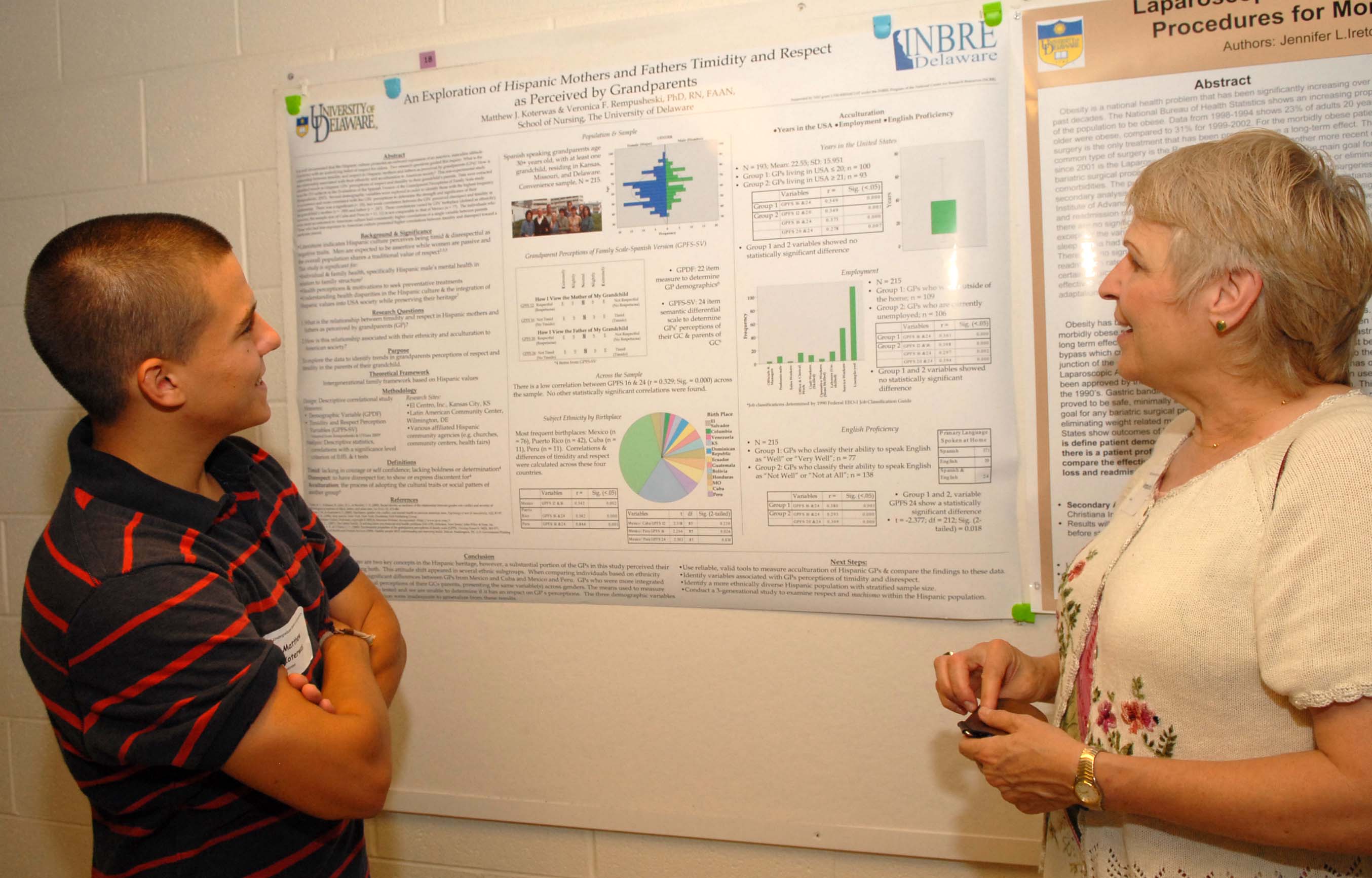 An Exploration of Hispanic Mothers and Fathers Timidity and Respect Matthew J. Koterwas and Veronica F. Rempusheski It is well
documented that the Hispanic culture promotes an outward expression of
an
assertive, masculine attitude (Machismo)
with an underlying belief of respect for elders. Two
research questions guided this inquiry:
What is the relationship between timidity and respect in Hispanic
mothers and
fathers as perceived by grandparents (GPs)? How is this relationship
associated
with their ethnicity and acculturation to American society? This non-experimental study identified trends
in Hispanic GPs’ perceptions of respect and timidity in their
grandchild’s parents. Data were extracted
from the 215 subjects in
the Evaluation of the Spanish Version of the Grandparent Perceptions of
Family
Scale study (Rempusheski, 2007). Several
demographic variables were explored in order to identify those with the
highest
frequency of occurrence and were correlated with the GPs’ perceptions
to
determine the strength and significance of their relationship. There was a significant (< .05), but weak
correlation between the GPs’ perceived disrespect and timidity in the
grandchild’s mother (r = .189) and father (r = .247).
These correlations varied by GPs’ birthplace
(defined as ethnicity); however, the sample size of |
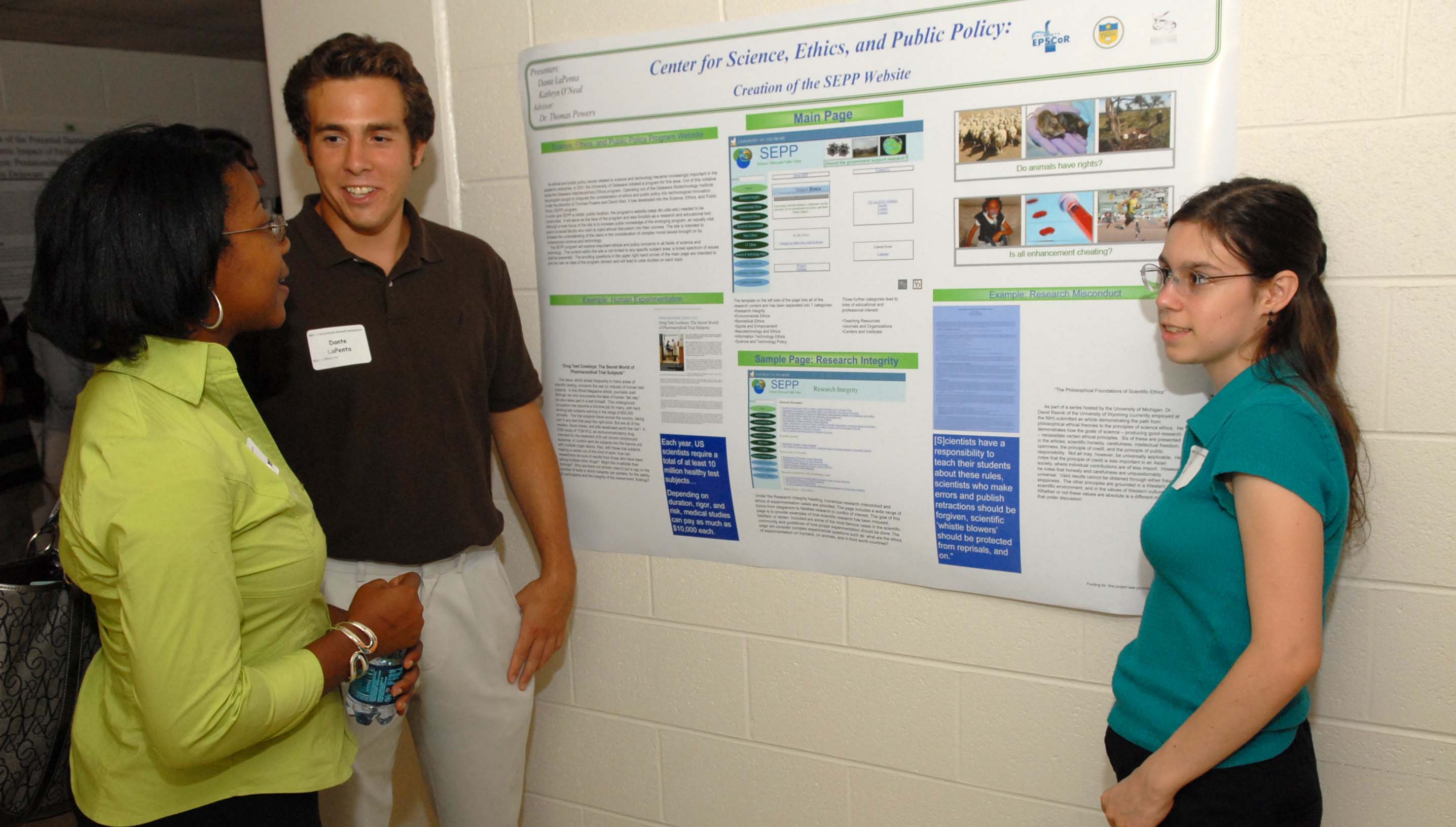 Science, Ethics, and Public Policy (SEPP) Program Website Dante LaPenta, Kathryn O’Neal, and Thomas Powers Delaware Biotechnology Institute .The SEPP program
will explore important ethical and policy concerns in all fields of
science and
technology. The content within the site
is not limited to any specific subject area; a broad spectrum of issues
shall
be presented. The scrolling questions in
the upper right hand corner of the main page are intended to give the
user an
idea of the program domain and will lead to case studies on each topic. The template on the left side of the page
lists all of the research content and has been separated into 7
categories: Research Integrity
Environmental Ethics Biomedical Ethics Sports and Enhancement Nanotechnology and Ethics Information Technology Ethics Science and Technology Policy Three further categories
lead to links of educational and
professional interest: Teaching Resources
Journals and Organizations Centers and Institutes Each of these categories
has been carefully constructed to
give the user the best available content and has been sub-divided into
more
specific groupings to allow for faster, more efficient use. Funding for
this
project was provided by NSF-ESPCoR. |
|
Does Heading Frequency Affect Neuropsychological Test Performance In Interscholastic Female Soccer Players? Taima A. McCartney and Thomas W. Kaminski Athletic Training Research Laboratory Recent media
attention has been given to the sport
of soccer and most notably purposeful heading and whether or not it is
dangerous to the brain. Objective:
The purpose of this study was to compare baseline and post-season
neuropsychological
(NP) scores in interscholastic female soccer players to determine if
there was
a decline in performance in those who head the ball more often. Methods: A total of 316 female soccer
players participated and were divided into four groups based on their
number of
total headers during a playing season: 0 headers (N = 19); 1 – 15
headers (N =
150); 16 – 42 headers (N = 74); and 43+ headers (N = 73). Subjects were
administered the computerized Automated Neuropsychological Assessment
Metrics (ANAM)
test battery prior to and at the conclusion of their playing season. The number of headers were recorded during
the season and totaled after the last game. Throughput scores (measures
of
performance speed and accuracy) were taken from the ANAM test battery
for the
Simple Reaction Time (SRT), Math Processing Test (MTH), Continuous
Performance
Test (CPT), Matching to Sample (MSP), Sternberg Memory Test (ST6),
Repeat
Simple Reaction Time (RSRT), and Repeat Continuous Performance Test
(RCPT). Scores
were analyzed using a mixed model ANOVA with repeated measures. Results:
There were no significant interactions between group status and time. There were significant time main effects (P
< .05) for the MTH, CPT, ST6, and RCPT measures. The pooled (across
all
groups) throughput scores for these variables improved from baseline to
post-season. Conclusions: It
doesn’t appear that the total number of
headers accumulated over the course of a playing season affects NP test
performance in this group of soccer players. Interestingly
there was improved performance (higher
throughput scores)
on four of the seven variables measured, with a trend toward
improvement on one
other. These changes in throughput
scores are most likely associated with learning effects.
This
project was funded by the
|
|
Coordination of upper and lower extremity
forces in
bi-directional static force production tasks.
Laura Jane Penneys, Jim Richards, Slobodan Jaric, Venilla Krishnan Department of Health, Nutrition and Exercise Sciences Interpretation
of the coordination between the grip (normal force that prevents
slippage) and
the load force (tangential gravitational force) within the human hands
has been
shown to reveal neurological impairments. While
these factors can be determined from grasping
techniques, the
lower body has yet to be examined for these neurological signs. In this study, we tested to see if there
is
a central control mechanism governing load/grip and shear/normal
coordination,
or whether the upper extremities are controlled separately from the
lower
extremities. We tested the hypothesis
that both upper and lower extremities would be controlled by a similar
source,
showing comparable load/grip and shear/normal forces.
Subjects performed bi-directional static
force production tasks at 60 hz with their hands, palms, and feet. We then performed statistical analysis for
task performance between the hand and foot, grip/load ratio, cross
correlation,
regression, and Eigenvectors for each subject, and a MANOVA for all
subjects. In the pilot study we found a
correlation of 0.846 between the palm trials and the foot trials, 0.568
between
the foot trials and grip trials, and 0.813 between the grip trials and
the palm
trials, indicating promising results for the remainder of the study. Funding provided by the Undergraduate
Research Program. |
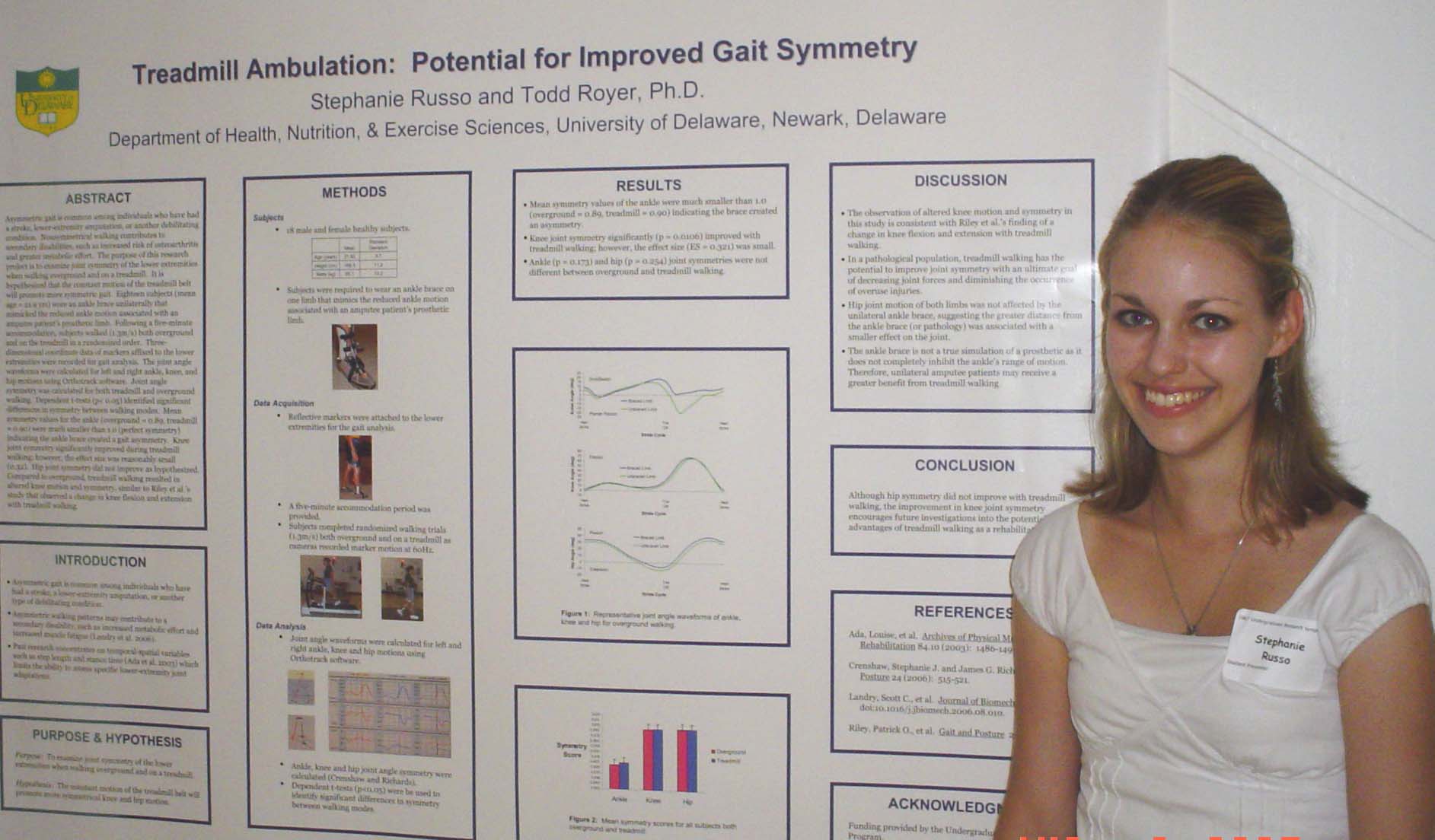 Treadmill Ambulation: Potential for Improved Gait Symmetry Stephanie Russo and Todd Royer Department of Health, Nutrition and Exercise Sciences Asymmetric
gait is common among individuals who have had a stroke, lower-extremity
amputation, or another debilitating condition. Nonsymmetrical
walking contributes to secondary
disabilities, such as increased
risk of osteoarthritis and greater metabolic effort.
The purpose of this research project is to
examine joint symmetry of the lower extremities when walking overground
and on
a treadmill. It is hypothesized that the
constant motion of the treadmill belt will promote more symmetric gait. Eighteen subjects (mean age = 21.9 yrs) wore
an
ankle brace unilaterally that mimicked the reduced ankle motion
associated with
an amputee patient’s prosthetic limb. Following
a five-minute accommodation, subjects walked
(1.3m/s) both
overground and on the treadmill in a randomized order.
Three-dimensional coordinate data of markers
affixed to the lower extremities were recorded for gait analysis. The joint angle waveforms were calculated for
left and right ankle, knee, and hip motions using Orthotrack software. Joint angle symmetry was calculated for both
treadmill and overground walking. Dependent
t-tests (p< 0.05) identified significant differences in symmetry
between
walking modes. Mean symmetry values for
the ankle (overground = 0.89, treadmill = 0.90) were much smaller than
1.0 (perfect
symmetry) indicating the ankle brace created a gait asymmetry. Knee joint symmetry significantly improved
during treadmill walking; however, the effect size was reasonably small
(0.32). Hip joint symmetry did not
improve as hypothesized. Compared to
overground, treadmill walking resulted in altered knee motion and
symmetry,
similar to Riley et al.’s study that observed a change in knee flexion
and
extension with treadmill walking. Funding
was provided by the Undergraduate Research Program.
|
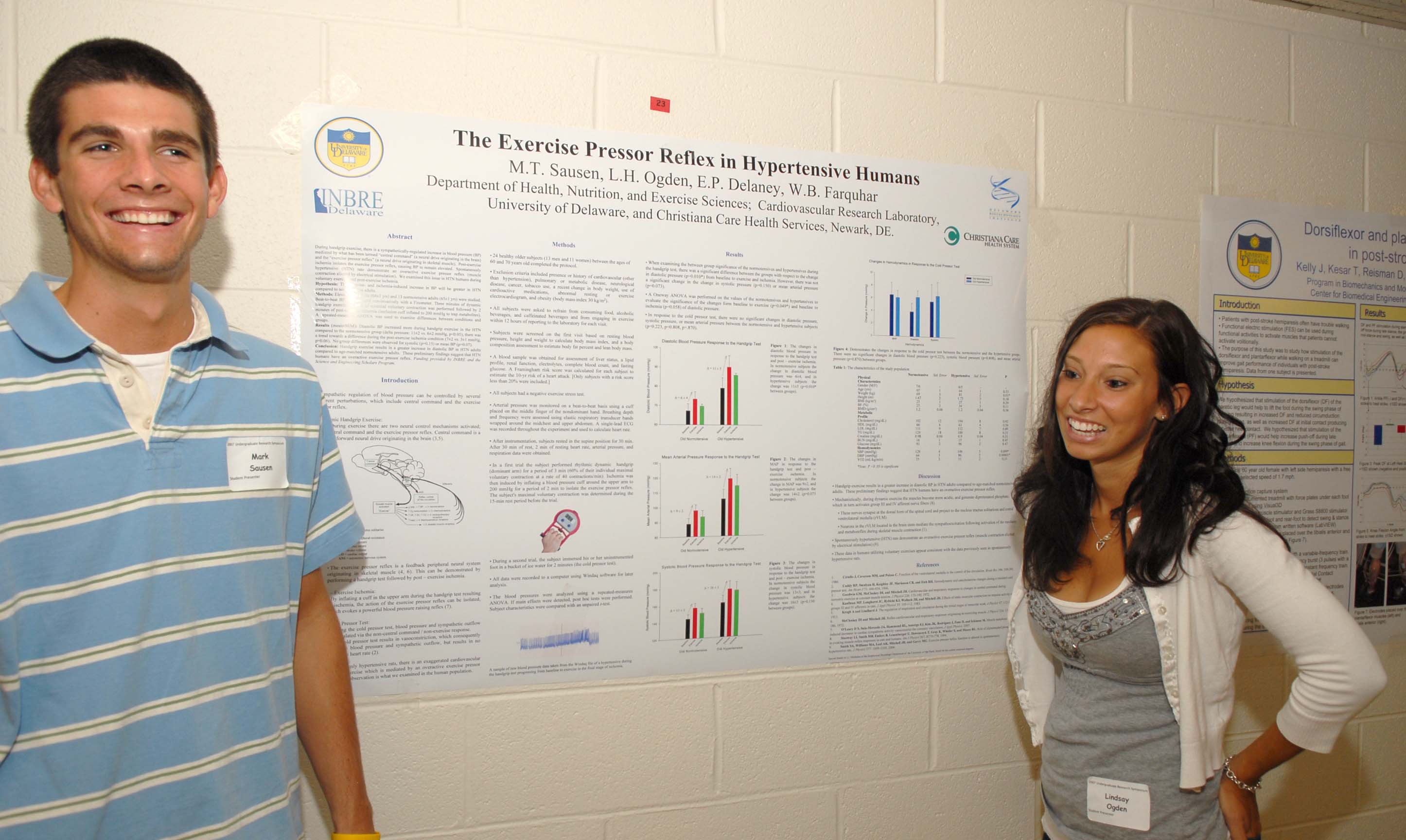 Exercise Pressor Reflex in Hypertensive Humans Mark T Sausen, Lindsay H Ogden, EP Delaney, WB Farquhar Department of Physical Therapy Hypothesis: The exercise- and
ischemia-induced
increase in BP will be greater in HTN compared to normotensive adults. Methods: Eleven HTN adults
(64±1 yrs) and 13
normotensive adults(65±1 yrs) were
studied. Beat-to-beat BP was assessed
non-invasively
with a Finometer. Three minutes of dynamic handgrip exercise at 60% of
maximal
voluntary contraction was performed followed by 2 minutes of
post-exercise
ischemia (occlusion cuff inflated to 200 mmHg to trap metabolites). A repeated-measures ANOVA was used to examine
differences between conditions and groups. Results (mean±SEM): Diastolic
BP increased more during handgrip exercise in the HTN compared to the
normotensive group (delta pressure: 11±2 vs. 6±2 mmHg,
p<0.05); there was a
trend towards a difference during the post-exercise ischemia condition
(7±2 vs.
3±1 mmHg, p=0.06). No group
differences
were observed for systolic (p=0.15) or mean BP (p=0.07).
Conclusion: Handgrip
exercise results in a greater increase in diastolic BP in HTN adults
compared
to age-matched normotensive adults. These
preliminary findings suggest that HTN humans have an
overactive
exercise pressor reflex. Funding provided by INBRE and the Science
and
Engineering Scholars Program. |
|
Yersinia
pestis is a
facultative intracellular gram-negative bacillus. It
is the causative agent of plague and was
responsible for the “Black Death,” which killed between one third and
two
thirds of |
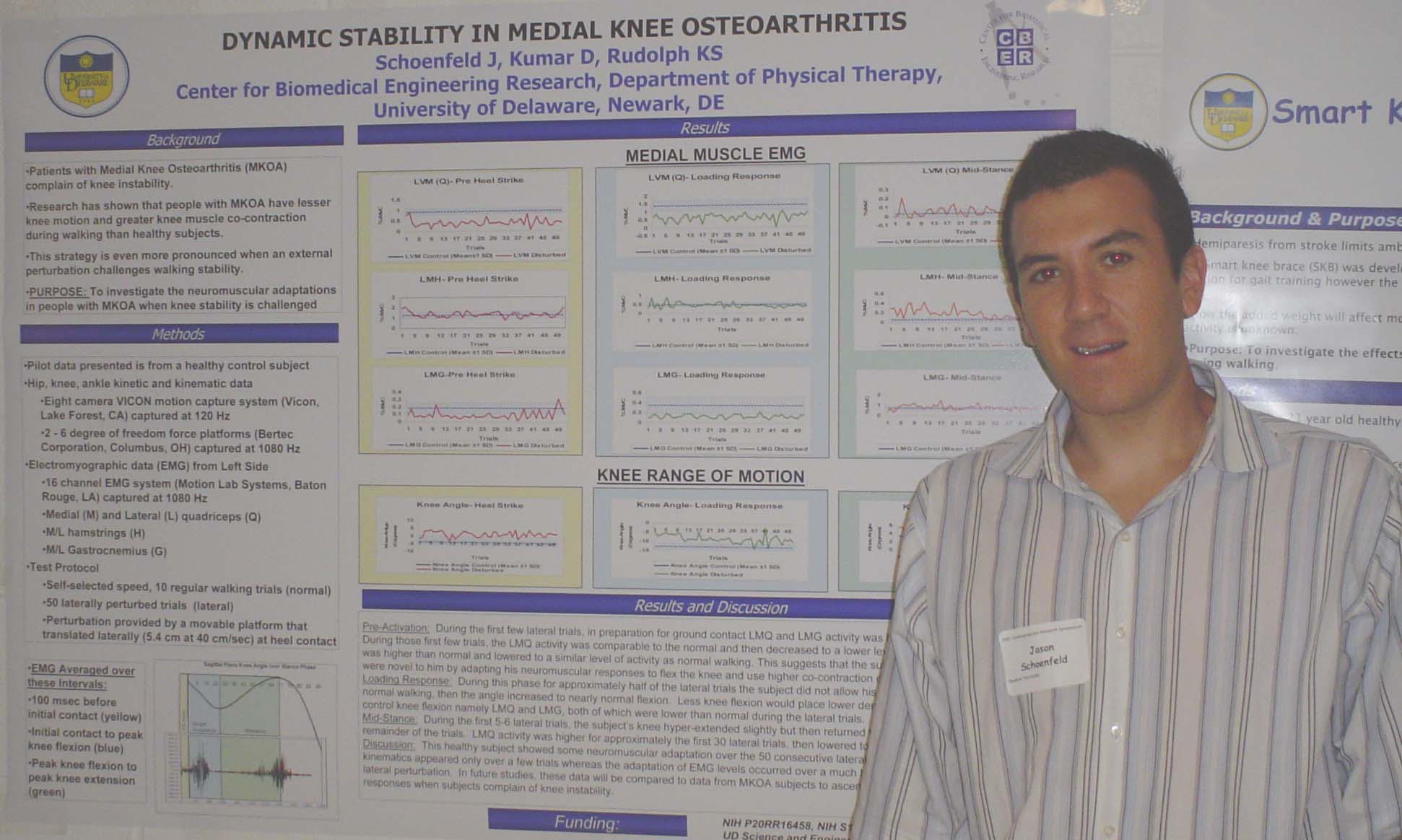 Dynamic Stability in Medial Knee Osteoarthritis Jason Schoenfeld, Deepak Kumar, Katherine S. Rudolph Department of Physical Therapy Patients with Medial Knee
Osteoarthritis (MKOA) complain of knee instability and research has
shown that
people with MKOA have lesser knee motion and greater knee muscle
co-contraction
during walking than healthy subjects. This
strategy is even more pronounced when an external
perturbation
challenges walking stability. In this
study we investigated neuromuscular adaptations in people with MKOA
when
exposed to repeated perturbations. Pilot
data from one healthy control subject is presented here.
Kinetic, kinematic, and EMG data were collected
as the subject walked at a self-selected speed for 10 regular trials
followed
by 50 consecutive perturbation trials. During
perturbation trials a movable platform translated
laterally at
heel strike. The EMG data were averaged
over three intervals: 100 msec before heel strike; heel strike to peak
knee
flexion(PKF) (loading response) and PKF to peak knee extension
(mid-stance). During the perturbation
trials the subject showed unchanging muscle activity that was
comparable to
regular walking. During the first few
perturbation trials, the knee flexion at heel strike was greater than
normal. Over the 50 trials, the knee
angle gradually decreased to a value similar to regular walking and
then
remained constant. The knee angle at
loading response and mid-stance was not different from normal walking
trials. The data indicate very little
adaptation when dynamic stability was challenged. These
data will be compared to data from MKOA
subjects to ascertain the differences in neuromuscular response
strategies. Funding: National
Institute of Health (P20 RR16458);
|
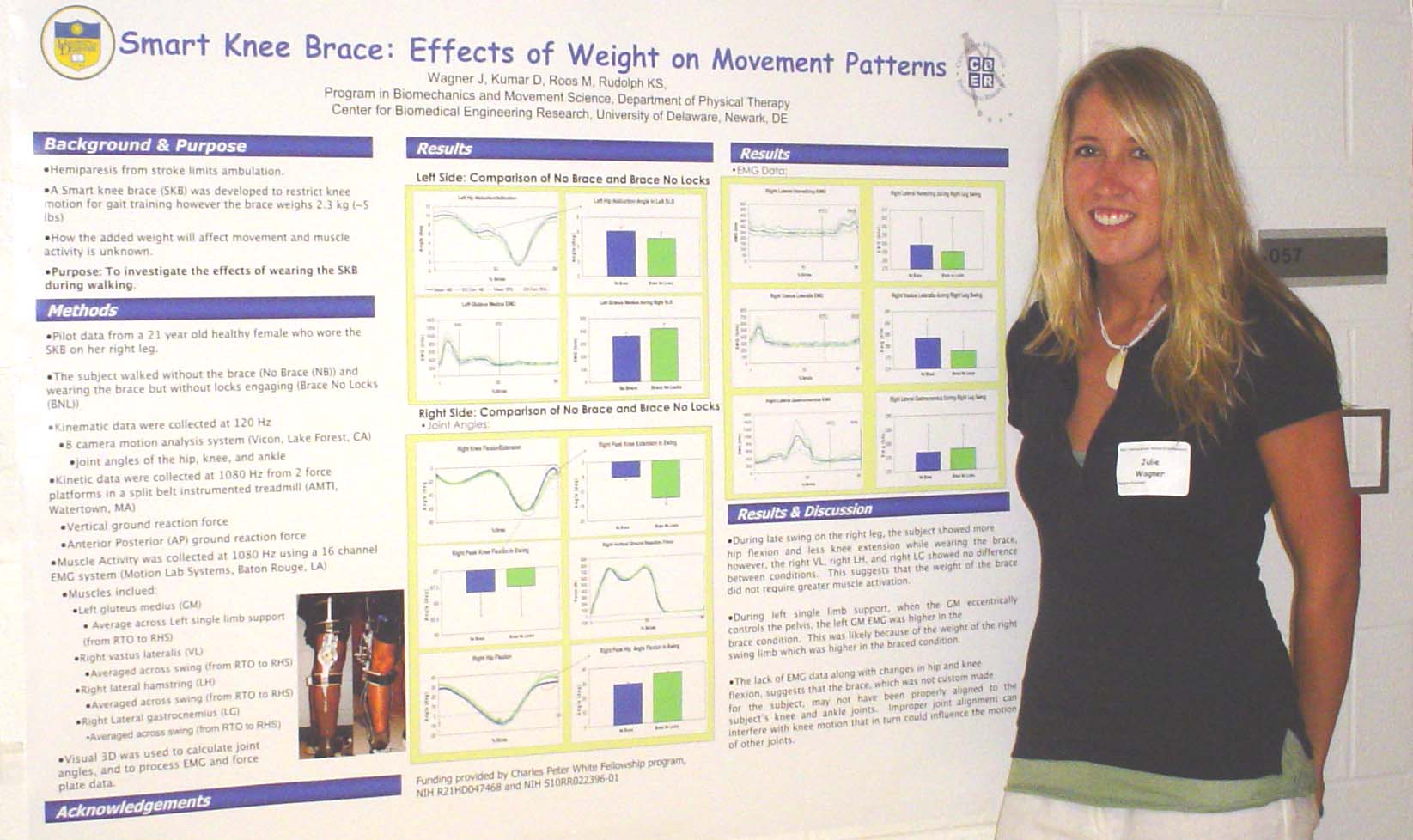 Smart Knee Brace: Effects of Weight on Movement Patterns Julie Wagner, M. Roos, D. Kumar, Katherine S. Rudolph Department of Physical Therapy Hemiparesis
from stroke limits ambulation. We have
developed a smart knee brace (SKB) that restricts knee motion for gait
training
however the brace weighs 2.3 kg and it is unclear what effect the
weight will
have on joint movement and muscle activity. In
this study we investigate the effects of wearing the
SKB during
walking. Pilot data from a 21 year old
healthy female is presented. The subject
walked on an instrumented treadmill using 2 conditions (1) no brace and
(2)
wearing the brace on the right leg with knee free to move.
Motion analysis and EMG systems were used to
collect muscle activity (EMG) and joint angles. While
wearing the brace the subject used greater hip
flexion and less
knee extension during late swing on the right. The
right vastus lateralis, lateral hamstring, and lateral
gastrocnemius
showed no differences between conditions. However,
the left gluteus medius EMG, that controls the
pelvis during
right swing phase, was higher in the brace condition.
We would have expected the added weight of
the brace to require greater muscle activation during walking, however,
only
the left hip abductors showed increased activity. The
lack of EMG differences coupled with
changes in hip and knee flexion, suggests that the brace, which was not
custom
made for this subject, was not aligned to the knee joint perfectly. Improper fit of the SKB could interfere with
knee movement that could influence the movement of other joints. Funding: UD
Undergraduate Research Peter White Fellowship, NIH
R21HD047468 |